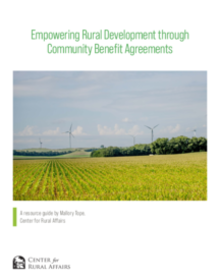Renewable energy projects offer significant opportunities for rural communities, including the stimulation of economic growth and job creation. In recent years there have been efforts to unlock new possibilities for counties to gain additional financial and non-financial benefits from renewable energy development. Some rural communities have used Community Benefit Agreements with clean energy developers to outline how proposed projects can help rural areas thrive.
Solar and wind energy are key components of America’s goal to reach a carbon-free power grid by 2035 and are expected to generate 60% of the country’s electricity by the end of that timeframe.
Rural communities also factor in meeting the country’s carbon-free goal. According to the U.S. Department of Energy, about 90% of projected solar development by 2050 is expected to occur in rural settings. Community Benefit Agreements can help ensure wind and solar energy projects empower and uplift communities.
This resource guide is intended to provide local leaders and developers with information about the agreements and their effect on renewable energy development. First, we will take a look at what Community Benefit Agreements are and the different types of them. Then we’ll share best practices for communities and developers creating such agreements. Finally, we will focus on the success stories of communities with renewable energy projects and Community Benefit Agreements across Iowa, Minnesota, and South Dakota.


